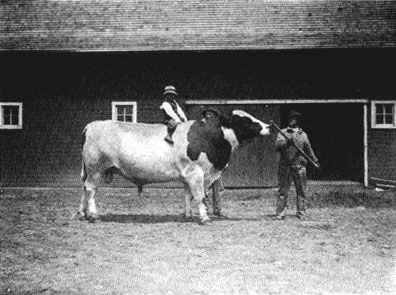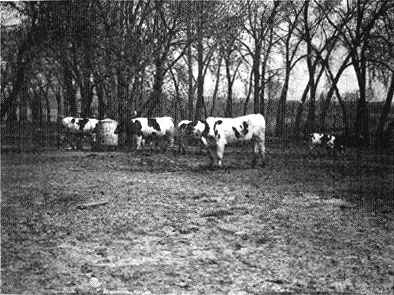![]()

Holstein Bull, LeRoy Ball Dairy Farm, Albion, Nebr. produces most of her millions of bushels of wheat and much of the corn. Grain farming is quite generally practiced, small grain being the principal crop, due to the occasional lack of moisture during the critical season for corn. The uncertainty of rein/all in parts of this region makes it profitable to maintain a dairy herd to bring in an income on the roughage produced when crop failures and near failures occur, for sufficient roughage can usually be grown to winter the stock. In the northwestern part of the state is the vast sandhill region. The land is sandy and hilly, and not much of it is under tillage. While some crops are raised in that area, difficulty in marketing and instability of the soil make grain farming less profitable than livestock farming. The hills furnish grazing for a large number of cattle. Creameries are being built and dairying more extensively taken up. The climate of Nebraska is often mild in winter, though somewhat variable. Long periods of uniformly cold weather rarely occur. While frosts come late in the spring some years, they rarely occur early in the fall south of the Platte. |
![]()
is more than three tons. Wheat is so extensively grown that cheap mill products from this grain are generally available under normal conditions. The soil is especially well adapted to the growth of roots. In the irrigated section of the broad Platte valley enormous quantities of sugar beets are grown and utilized by large sugar factories at Scottsbluff, Gering, Bayard and Grand Island. The beet pulp by-product of these mills, constituting a cheap source of carbohydrate feed, is used extensively in feeding cattle. Quantities of sorghum, millet, sweet clover and Kaffir are grown in the drier sections where common feeds grow with difficulty. An adequate supply of energy-producing roughage is thus secured. From the cheaper lands of the state an abundance of prairie hay is produced. In much of the western part of the state cheap lands with plenty of pasture and a long grazing season enable the farmer to produce milk at a low figure. It is necessary to feed alfalfa or oilmeal with the principal roughage of this portion of the state to meet the needs of the cow. The fertility of the soil, together with the ease of working it and the fact that but small areas of the tillable land are encumbered with rocks or timber, makes the production of winter feeds cheap and plentiful. The production of so much roughage makes Nebraska a desirable dairy state. Roughage is bulky and the cost of shipping and marketing is very expensive. The Nebraska farmer is not near to the regions where the demand for such feeds is keen. They must be shipped to some distant locality in the east to obtain a good market. The cost of shipping these bulky products greatly decreases the profits derived from their sale. It is a significant fact that the eastern farmer can buy such expensive products and by feeding them to dairy cows realize a good profit upon his investment. The prices paid for dairy products in the east are little better than those received by western farmers. Nebraska farmers are beginning to realize that they, too, can profit by feeding grain and surplus roughage to dairy cows. Thus they are enabled not only to make the profit they did formerly on the sale of their surplus farm crops, but are also saved the time and expense of hauling these bulky products to market. In addition they make the profit derived from feeding the crops to the home herd. It is true that other classes of animals may be fed and the cost of marketing lessened, but no other animal is so efficient in converting the nutrients in plant roughage into human food as the dairy cow. In one year a good dairy cow will produce as much food matter in her milk as is found in the carcasses of five 1,100 pound steers. It is obvious that she will not eat as much in one year as these steers have consumed in maturing to that size. In fact, she will eat but little more than will one of these steers in his last year of feeding. When the steer is butchered his work is done, but the cow stands ready to repeat her performance every year. It is evident that the dairy cow, of all live stock, is of greatest economic value in conserving for human consumption the food nutrients produced from our soils. Nor are our soils injured by this mode of farming. The farmers over the state are beginning to notice that their soil does not produce as bountifully as did the virgin prairie a generation ago. This may be attributed to the constant drain of soil fertility, resulting from a system of grain farming. Every ton of wheat has carried away with it fertilizing elements, which, if they had to be pur- |
![]()
 |
 |
 |
© 2002 for the NEGenWeb Project by Pam Rietsch, Ted & Carole Miller
